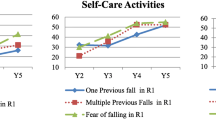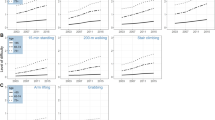Abstract
Objectives
This study examined the longitudinal relationship between mobility device use, falls and fear of falling (FOF) among community-dwelling older adults by frailty status over a one-year follow-up.
Design
A longitudinal cohort study.
Setting
Communities in the United States.
Participants
Community-dwelling older adults from the National Health and Aging Trends Study, a nationally representative survey of Medicare Beneficiaries in the United States (N=5,896).
Measurements
Based on yes or no response to the corresponding items for the variables, fall-related outcomes were determined separately including falls and FOF. Falls were assessed by asking participants whether they had a fall and if they had fallen down more than one time. FOF was measured by asking participants whether they worried about falling and if this worry ever limited activities. Mobility device use was determined by asking whether participants used any type of mobility devices and the number of devices used, including cane, walker, wheelchair and scooter. Frailty was assessed using the frailty phenotype. Multinomial logistic regression models were conducted to examine the association between mobility device use and fall-related outcomes among older adults by frailty status.
Results
At Year 1, 28.6% of participants reported using mobility devices. Among robust participants, using one mobility device had 3.58 times higher risks of FOF with fear-related activity restriction (FAR) than non-device users (95% CI: 1.10–11.65). Cane-only robust users had 5.94 and 2.18 times higher risks of FOF with and without FAR (95% CI: 1.80–19.57; 95% CI: 1.12–4.22) than non-device users. Among pre-frail participants, using one mobility device was associated with recurrent falls and FOF with FAR (RRR=2.02, 95% CI: 1.30–3.14; RRR=2.13, 95% CI: 1.25–3.63). Using ≥2 devices was associated with one fall (RRR=2.08, 95% CI: 1.30–3.33), recurrent falls (RRR=2.92, 95% CI: 1.62–5.25) and FOF with FAR (RRR=2.84, 95% CI: 1.34–6.02). Pre-frail cane-only users were more likely to have one fall (RRR=1.57, 95% CI: 1.06–2.32), recurrent falls (RRR=2.36, 95% CI: 1.48–3.77) and FOF with FAR (RRR=2.08, 95% CI: 1.12–3.87) than non-device users. The number of mobility device used and the use of canes failed to be significantly associated with fall-related outcomes among frail participants.
Conclusion
The number of mobility devices used and the only use of canes were associated with fall-related outcomes among robust and pre-frail individuals. Further research is needed to develop targeted strategies for preventing falls and FOF among older adults with mobility device use, particularly for those in the early stages of frailty.
Similar content being viewed by others
References
Lohman MC, Sonnega AJ, Nicklett EJ, Estenson L, Leggett AN, Newman A. Comparing Estimates of Fall-Related Mortality Incidence among Older Adults in the United States. Journals Gerontol - Ser A Biol Sci Med Sci. 2019;74(9):1468–1474. doi:https://doi.org/10.1093/gerona/gly250
Gill TM, Murphy TE, Gahbauer EA, Allore HG. Association of injurious falls with disability outcomes and nursing home admissions in community-living older persons. Am J Epidemiol. 2013;178(3):418–425. doi:https://doi.org/10.1093/aje/kws554
Rivasi G, Kenny RA, Ungar A, Romero-Ortuno R. Predictors of Incident Fear of Falling in Community-Dwelling Older Adults. J Am Med Dir Assoc. 2020;21(5):615–620. doi:https://doi.org/10.1016/j.jamda.2019.08.020
Jamison M, Neuberger GB, Miller PA. Correlates of falls and fear of falling among adults with rheumatoid arthritis. Arthritis Rheum. 2003;49(5):673–680. doi:https://doi.org/10.1002/art.11383
Delbaere K, Close JC, Brodaty H, Sachdev P, Lord SR. Determinants of disparities between perceived and physiological risk of falling among elderly people: cohort study. BMJ. 2010;341:c4165. Published 2010 Aug 18. doi:https://doi.org/10.1136/bmj
Florence CS, Bergen G, Atherly A, Burns E, Stevens J, Drake C. Medical Costs of Fatal and Nonfatal Falls in Older Adults. J Am Geriatr Soc. 2018;66(4):693–698. doi:https://doi.org/10.1111/jgs.15304
Burns ER, Stevens JA, Lee R. The direct costs of fatal and non-fatal falls among older adults — United States. J Safety Res. 2016;58:99–103. doi:https://doi.org/10.1016/j.jsr.2016.05.001
Brown CJ, Flood KL. Mobility limitation in the older patient: A clinical review. JAMA - J Am Med Assoc. 2013;310(11):1168–1177. doi:https://doi.org/10.1001/jama.2013.276566
Pellicer-García B, Antón-Solanas I, Ramón-Arbués E, García-Moyano L, Gea-Caballero V, Juárez-Vela R. Risk of Falling and Associated Factors in Older Adults with a Previous History of Falls. Int J Environ Res Public Health. 2020;17(11):4085. Published 2020 Jun 8. doi:https://doi.org/10.3390/ijerph17114085
Roman De Mettelinge T, Cambier D. Understanding the relationship between walking AIDS and falls in older adults: A prospective cohort study. J Geriatr Phys Ther. 2015;38(3):127–132. doi:https://doi.org/10.1519/JPT.0000000000000031
Choi NG, Sullivan JE, Marti CN. Low-income homebound older adults receiving home-delivered meals: Physical and mental health conditions, incidence of falls and hospitalisations. Heal Soc Care Community. 2019;27(4):e406–e416. doi:https://doi.org/10.1111/hsc.12741
West BA, Bhat G, Stevens J, Bergen G. Assistive device use and mobility-related factors among adults aged ≥ 65 years. J Safety Res. 2015;55:147–150. doi:https://doi.org/10.1016/j.jsr.2015.08.010
Anderson LK, Lane K. Characteristics of falls and recurrent falls in residents of an aging in place community: A case-control study. Appl Nurs Res. 2020;51. doi:https://doi.org/10.1016/j.apnr.2019.151190
Gell NM, Wallace RB, Lacroix AZ, Mroz TM, Patel K V. Mobility device use in older adults and incidence of falls and worry about falling: Findings from the 2011–2012 national health and aging trends study. J Am Geriatr Soc. 2015;63(5):853–859. doi:https://doi.org/10.1111/jgs.13393
Kojima G. Frailty as a Predictor of Future Falls Among Community-Dwelling Older People: A Systematic Review and Meta-Analysis. J Am Med Dir Assoc. 2015;16(12):1027–1033. doi:https://doi.org/10.1016/j.jamda.2015.06.018
Makino K, Lee S, Bae S, et al. Prospective Associations of Physical Frailty With Future Falls and Fear of Falling: A 48-Month Cohort Study. Phys Ther. 2021;101(6). doi:https://doi.org/10.1093/ptj/pzab059
Gale CR, Cooper C, Sayer AA ihi. Prevalence of frailty and disability: findings from the English Longitudinal Study of Ageing. Age Ageing. 2015;44(1):162–165. doi:https://doi.org/10.1093/ageing/afu148
Cruz A de O, Santana SMM, Costa CM, Gomes da Costa LV, Ferraz DD. Prevalence of falls in frail elderly users of ambulatory assistive devices: a comparative study. Disabil Rehabil Assist Technol. 2020;15(5):510–514. doi:https://doi.org/10.1080/17483107.2019.1587016
Griffith L, Sohel N, Walker K, et al. Consumer products and fall-related injuries in seniors. Can J Public Health. 2012;103(5):e332–e337. Published 2012 Jul 18. doi:https://doi.org/10.1007/BF03404436
Kasper JD, Freedman VA. Findings from the 1st round of the National Health and Aging Trends Study (NHATS): introduction to a special issue. J Gerontol B Psychol Sci Soc Sci. 2014;69 Suppl 1:S1–S7. doi:https://doi.org/10.1093/geronb/gbu125
Bandeen-Roche K, Seplaki CL, Huang J, et al. Frailty in Older Adults: A Nationally Representative Profile in the United States. Journals Gerontol - Ser A Biol Sci Med Sci. 2015;70(11):1427–1434. doi:https://doi.org/10.1093/gerona/glv133
Siriwardhana DD, Hardoon S, Rait G, et al. Prevalence of frailty and prefrailty among community-dwelling older adults in low-income and middle-income countries: a systematic review and meta-analysis. BMJ Open. 2018;8(3):e018195. doi:https://doi.org/10.1136/bmjopen-2017-018195
Ellmers TJ, Delbaere K, Kal EC. Frailty, falls and poor functional mobility predict new onset of activity restriction due to concerns about falling in older adults: a prospective 12-month cohort study. Eur Geriatr Med. 2023;14(2):345–351. doi:https://doi.org/10.1007/s41999-023-00749-2
Korenhof SSA, van Grieken AA, Franse CCB, et al. The association of fear of falling and physical and mental Health-Related Quality of Life (HRQoL) among community-dwelling older persons; a cross-sectional study of Urban Health Centres Europe (UHCE). BMC Geriatr. 2023;23(1):291. doi:https://doi.org/10.1186/s12877-023-04004-y
Chong EY, Lim AH, Mah FCY, et al. Assessing the psychosocial dimensions of frailty among older adults in Singapore: a community-based cross-sectional study. BMJ Open. 2022;12(2):e047586. doi:https://doi.org/10.1136/bmjopen-2020-047586
Dickson NC, Gohil AR, Unsworth CA. Powered mobility device use in residential aged care: a retrospective audit of incidents and injuries. BMC Geriatr. 2023;23(1):363. doi:https://doi.org/10.1186/s12877-023-04073-z
Dent E, Morley JE, Cruz-Jentoft AJ, et al. Physical Frailty: ICFSR International Clinical Practice Guidelines for Identification and Management. J Nutr Health Aging. 2019;23(9):771–787. doi:https://doi.org/10.1007/s12603-019-1273-z
Gill TM, Gahbauer EA, Allore HG, et al. Transitions between frailty states among community-living older persons. Arch Intern Med. 2006;166(4):418–423. doi:https://doi.org/10.1001/archinte.166.4.418
Luz C, Bush T, Shen X, et al. Do canes or walkers make any difference? nonuse and fall injuries. Gerontologist. 2017;57(2):211–218. doi:https://doi.org/10.1093/geront/gnv096
Resnik L, Allen S, Isenstadt D, et al. Perspectives on use of mobility aids in a diverse population of seniors: Implications for intervention. Disabil Health J. 2009;2(2):77–85. doi:https://doi.org/10.1016/j.dhjo.2008.12.002
Borade N, Ingle A, Nagarkar A. Lived experiences of people with mobility-related disability using assistive devices. Disabil Rehabil Assist Technol. 2021;16(7):730–734. doi:https://doi.org/10.1080/17483107.2019.1701105
Hoffman GJ, Ha J, Alexander NB, et al. Underreporting of Fall Injuries of Older Adults: Implications for Wellness Visit Fall Risk Screening. J Am Geriatr Soc. 2018;66(6):1195–1200. doi:https://doi.org/10.1111/jgs.15360
Acknowledgements
The publication of this manuscript was supported by the Youth Grant from the National Natural Science Foundation of China (Grant No. 72004237).
Funding
This work was supported by blinded for peer review.
Author information
Authors and Affiliations
Corresponding author
Ethics declarations
Conflict of interest statement: The authors declare no conflict of interest.
Ethical standards: The study complies with the current laws of the country in which it was performed.
Supplementary Material
Rights and permissions
About this article
Cite this article
Liu, M., Mo, C., Luo, Y. et al. Longitudinal Relationship between Mobility Device Use, Falls and Fear of Falling (FOF) Differed by Frailty Status among Community-Dwelling Older Adults. J Nutr Health Aging 27, 673–679 (2023). https://doi.org/10.1007/s12603-023-1952-7
Received:
Accepted:
Published:
Issue Date:
DOI: https://doi.org/10.1007/s12603-023-1952-7




